标签:rop sys make 关闭 done 配置 existing opera ble
contextlib模块包含的工具用于处理上下文管理器和with语句。
上下文管理器(context manager)负责管理一个代码块中的资源,会在进入代码块时创建资源,然后在退出代码块后清理这个资源。例如,文件就支持上下文管理器API,可以确保完成文件读写后关闭文件。
with open(‘test.txt‘, ‘wt‘) as f: f.write(‘contents go here‘)
上下文管理器由with语句启用,这个API包括两个方法。执行流进入with中的代码块时会运行__enter__()方法。它会返回在这个上下文中使用的一个对象。执行流离开with块时,则掉哟这个上下文管理器的__exit__()方法来清理所使用的资源。
class Context: def __init__(self): print(‘__init__()‘) def __enter__(self): print(‘__enter__()‘) return self def __exit__(self, exc_type, exc_val, exc_tb): print(‘__exit__()‘) with Context(): print(‘Doing work in the context‘)
相对于try:finally块,结合上下文管理器和with语句是一种更紧凑的写法,因为总会调用上下文管理器的__exit__()方法,即使产生异常的情况下也会调用这个方法。

如果with语句的as子句中指定了名,那么__enter__()方法可以返回与这个名关联的任何对象。在这个例子中,Context会返回一个使用打开的上下文的对象。
class WithinContext: def __init__(self, context): print(‘WithinContext.__init__({})‘.format(context)) def do_something(self): print(‘WithinContext.do_something()‘) def __del__(self): print(‘WithinContext.__del__‘) class Context: def __init__(self): print(‘Context.__init__()‘) def __enter__(self): print(‘Context.__enter__()‘) return WithinContext(self) def __exit__(self, exc_type, exc_val, exc_tb): print(‘Context.__exit__()‘) with Context() as c: c.do_something()
与变量c关联的值是__enter__()返回的对象,这不一定是with语句中创建的Context实例。

__exit__()方法接收一些参数,其中包含with块中产生的所有异常的详细信息。
class Context: def __init__(self, handle_error): print(‘__init__({})‘.format(handle_error)) self.handle_error = handle_error def __enter__(self): print(‘__enter__()‘) return self def __exit__(self, exc_type, exc_val, exc_tb): print(‘__exit__()‘) print(‘ exc_type =‘, exc_type) print(‘ exc_val =‘, exc_val) print(‘ exc_tb =‘, exc_tb) return self.handle_error with Context(True): raise RuntimeError(‘error message handled‘) print() with Context(False): raise RuntimeError(‘error message propagated‘)
如果上下文管理器可以处理这个异常,那么__exit__()应当返回一个true值来指示这个异常不需要传播。如果返回false,则会在__exit__()返回后再次抛出这个异常。
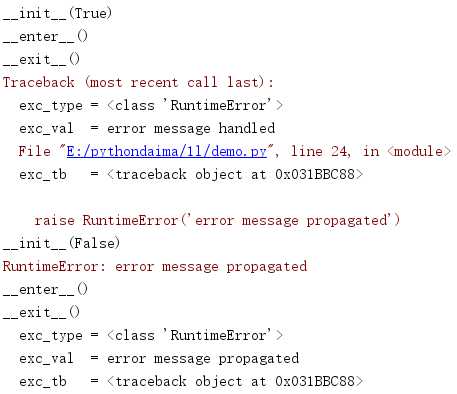
类ContextDecorator增加了对常规上下文管理器类的支持,因此其不仅可以作为上下文管理器,也可以作为函数修饰符。
import contextlib class Context(contextlib.ContextDecorator): def __init__(self, how_used): self.how_used = how_used print(‘__init__({})‘.format(how_used)) def __enter__(self): print(‘__enter__({})‘.format(self.how_used)) return self def __exit__(self, exc_type, exc_val, exc_tb): print(‘__exit__({})‘.format(self.how_used)) @Context(‘as decorator‘) def func(message): print(message) print() with Context(‘as context manager‘): print(‘Doing work in the context‘) print() func(‘Doing work in the wrapped function‘)
使用上下文管理器作为修饰符时有一点不同:__enter__()返回的值在被修饰的函数中不可用,这与使用with和as时不一样。传入被修饰函数的参数可以正常使用。
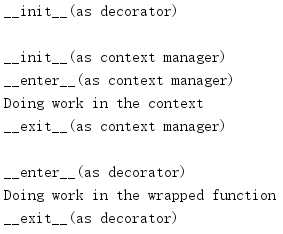
采用传统方式创建上下文管理器并不难,即编写一个包含__enter__()和__exit__()方法的类。不过有些时候,如果只有很少的上下文要管理,那么完整的写出所有代码便会成为额外的负担。在这些情况下,可以使用contextmanager()修饰符将一个生成器函数转换为上下文管理器。
import contextlib @contextlib.contextmanager def make_context(): print(‘ entering‘) try: yield {} except RuntimeError as err: print(‘ ERROR:‘, err) finally: print(‘ exiting‘) print(‘Normal:‘) with make_context() as value: print(‘ inside with statement:‘, value) print(‘\nHandled error:‘) with make_context() as value: raise RuntimeError(‘showing example of handling an error‘) print(‘\nUnhandled error:‘) with make_context() as value: raise ValueError(‘this exception is not handled‘)
生成器要初始化上下文,调用一次yield,然后清理上下文。所生成的值(如果有)会绑定到with语句as子句中的变量。with块中抛出的异常会在生成器中再次抛出,从而可以在生成器中得到处理。
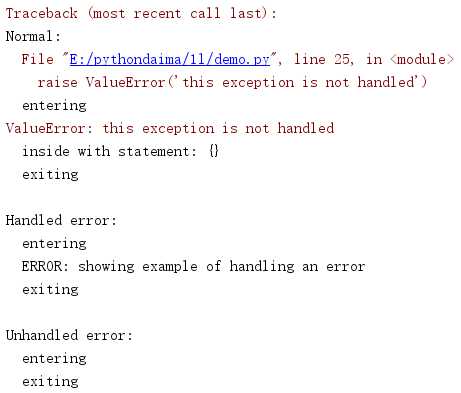
contextmanager()返回的上下文管理器派生自ContextDecorator,所以也可以被用作函数修饰符。
import contextlib @contextlib.contextmanager def make_context(): print(‘ entering‘) try: # Yield control, but not a value, because any value # yielded is not available when the context manager # is used as a decorator. yield except RuntimeError as err: print(‘ ERROR:‘, err) finally: print(‘ exiting‘) @make_context() def normal(): print(‘ inside with statement‘) @make_context() def throw_error(err): raise err print(‘Normal:‘) normal() print(‘\nHandled error:‘) throw_error(RuntimeError(‘showing example of handling an error‘)) print(‘\nUnhandled error:‘) throw_error(ValueError(‘this exception is not handled‘))
与前面的ContextDecorator例子一样,上下文管理器被用作修饰符时,生成器生成的值在被修饰的函数中不可用。传入被修饰函数的参数仍然可用,如这个例子中的throw_error()所示。
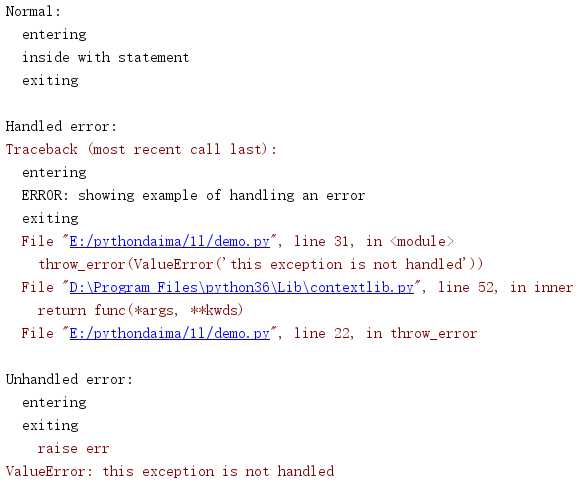
file类直接支持上下文管理器API,但另外一些表示打开句柄的对象却并不支持。contextlib的标准库文档中给出的示例是从urllib.urlopen()返回的对象。另外一些遗留的类会使用close()方法但不支持上下文管理器API。为了确保关闭句柄,要使用closing()为它创建一个上下文管理器。
import contextlib class Door: def __init__(self): print(‘ __init__()‘) self.status = ‘open‘ def close(self): print(‘ close()‘) self.status = ‘closed‘ print(‘Normal Example:‘) with contextlib.closing(Door()) as door: print(‘ inside with statement: {}‘.format(door.status)) print(‘ outside with statement: {}‘.format(door.status)) print(‘\nError handling example:‘) try: with contextlib.closing(Door()) as door: print(‘ raising from inside with statement‘) raise RuntimeError(‘error message‘) except Exception as err: print(‘ Had an error:‘, err)
不论with块中是否有错误,都会关闭这个句柄。
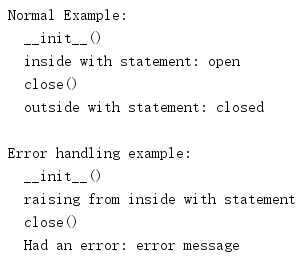
很多情况下,忽略库产生的异常通常很有用,因为这个错误可能会显示期望的状态已经被实现,否则该错误可以被忽略。要忽略异常,最常见的方法是利用一个try:except语句,其在except块中只包含一个pass语句。
class NonFatalError(Exception): pass def non_idempotent_operation(): raise NonFatalError( ‘The operation failed because of existing state‘ ) try: print(‘trying non-idempotent operation‘) non_idempotent_operation() print(‘succeeded!‘) except NonFatalError: pass print(‘done‘)
在这种情况下,这个操作会失败,而错误将被忽略。

try:except也可以被替换为contextlib.suppress(),以更显式的抑制with块中产生某一类异常。
import contextlib class NonFatalError(Exception): pass def non_idempotent_operation(): raise NonFatalError( ‘The operation failed because of existing state‘ ) with contextlib.suppress(NonFatalError): print(‘trying non-idempotent operation‘) non_idempotent_operation() print(‘succeeded!‘) print(‘done‘)
在这个更新后的版本中,异常会被完全丢弃。

设计不当的库代码可能会直接些sys.stdout或sys.stderr,而没有提供参数来配置不同的输出目标。可以用redirect_stdout()和redirect_stderr()上下文管理器从这些函数捕捉输出,因为无法修改这些函数的源代码来接收新的输出参数。
from contextlib import redirect_stdout, redirect_stderr import io import sys def misbehaving_function(a): sys.stdout.write(‘(stdout) A: {!r}\n‘.format(a)) sys.stderr.write(‘(stderr) A: {!r}\n‘.format(a)) capture = io.StringIO() with redirect_stdout(capture), redirect_stderr(capture): misbehaving_function(5) print(capture.getvalue())
在这个例子中,misbehaving_function()同时写至stdout和stderr,不过两个上下文管理器将这个输出发送到同一个io.StringIO实例,会在这里保存以备以后使用。

大多数上下文管理器都一次处理一个对象,如单个文件或数据库句柄。在这些情况下,对象是提前已知的,并且使用上下文管理器的代码可以建立这一个对象上。另外一些情况下,程序可能需要在一个上下文中常简未知数目的对象,控制流退出这个上下文时所有这些对象都要清理。ExitStack就是用来处理这些更动态的情况。
ExitStack实例会维护清理回调的一个栈数据结构。这些回调显式的填充在上下文中,在控制流退出上下文时会以逆序调用所有注册的回调。结果类似于有多个嵌套的with语句,只不过它们是动态建立的。
可以使用多种方法填充ExitStack。下面这个例子使用enter_context()来为栈增加一个新的上下文管理器。
import contextlib @contextlib.contextmanager def make_context(i): print(‘{} entering‘.format(i)) yield {} print(‘{} exiting‘.format(i)) def variable_stack(n, msg): with contextlib.ExitStack() as stack: for i in range(n): stack.enter_context(make_context(i)) print(msg) variable_stack(2, ‘inside context‘)
enter_context()首先在上下文管理器上调用__enter__()。然后把它的__exit__()方法注册为一个回调,撤销栈时将调用这个回调。
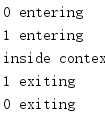
标签:rop sys make 关闭 done 配置 existing opera ble
原文地址:https://www.cnblogs.com/liuhui0308/p/12369259.html